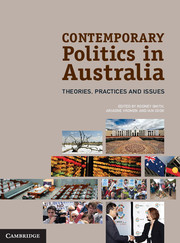Book contents
- Frontmatter
- Contents
- Tables and figures
- Contributors
- Acknowledgements
- Introduction
- I Contemporary Theories of Australian Politics
- Part II Politics in Everyday Australian Life
- Part III Elections
- Part IV Participation and Representation
- Introduction to Part IV
- 15 Participation and representation through political parties
- 16 Pressure groups and lobbying
- 17 Participatory and collaborative governance
- 18 New forms of participation and social movements
- Part V Inside the Australian State
- Part VI Contemporary Public Controversies
- Glossary
- References
- Index
- References
16 - Pressure groups and lobbying
from Part IV - Participation and Representation
Published online by Cambridge University Press: 05 June 2012
- Frontmatter
- Contents
- Tables and figures
- Contributors
- Acknowledgements
- Introduction
- I Contemporary Theories of Australian Politics
- Part II Politics in Everyday Australian Life
- Part III Elections
- Part IV Participation and Representation
- Introduction to Part IV
- 15 Participation and representation through political parties
- 16 Pressure groups and lobbying
- 17 Participatory and collaborative governance
- 18 New forms of participation and social movements
- Part V Inside the Australian State
- Part VI Contemporary Public Controversies
- Glossary
- References
- Index
- References
Summary
Any good understanding of the relationship between political institutions and societal actors in Australia must include a focus on the presence and influence of groups (see Chapters 2 and 3). Pressure groups have to be accounted for in contemporary theories of democracy (Chapter 1). In contrast to the previous chapter, this chapter makes the case that pressure groups, rather than parties, increasingly are the main link between citizens and government. This claim would hardly surprise pluralist theorists; however, whether the operation of pressure groups and lobbyists in Australia conforms to their broader assumptions about the way pluralist democracy should work is another matter (see Chapter 1). This chapter explores how open different institutions are to engagement with pressure groups and lobbyists. It highlights the dilemma for governments about whether to regulate the access and influence of groups and lobbyists, and how such regulation is affected by the prevailing political context (see Chapter 2).
- Type
- Chapter
- Information
- Contemporary Politics in AustraliaTheories, Practices and Issues, pp. 177 - 187Publisher: Cambridge University PressPrint publication year: 2012
References
- 1
- Cited by

